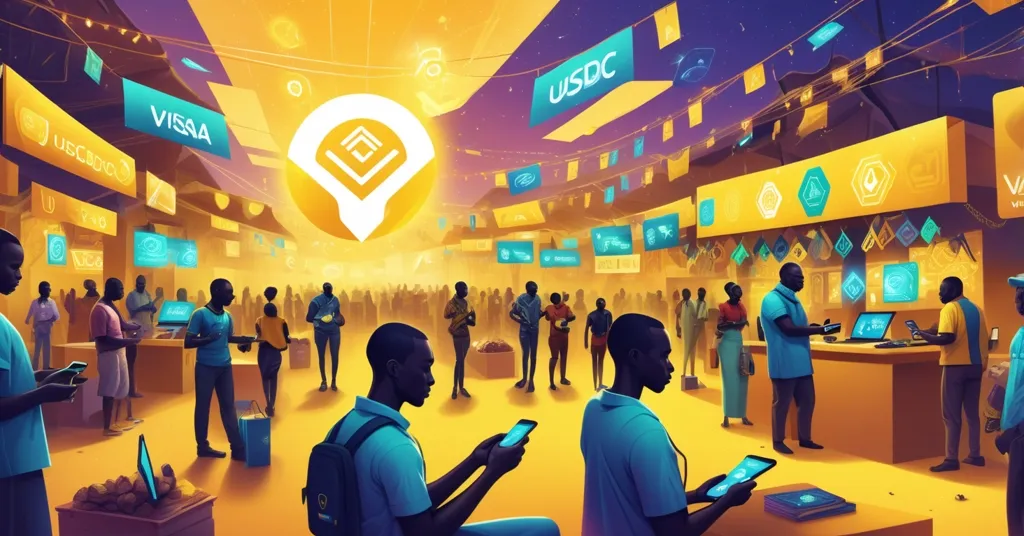Visa Partners with Yellow Card for Stablecoin Payments in 20 African Countries

Visa Teams Up with Yellow Card to Power Stablecoin Payments in 20 African Nations
Visa, a heavyweight in global payments, has forged a groundbreaking partnership with Yellow Card Financial, a top crypto exchange in Africa, to roll out stablecoin-powered transactions starting in 2025. This initiative, kicking off in an unnamed African country before scaling to broader markets by 2026, targets the deep-rooted inefficiencies of cross-border payments in a region desperate for financial solutions, leveraging digital dollars like USDC to slash costs and boost accessibility.
- Visa and Yellow Card partner to launch stablecoin payments in Africa, starting in 2025 with expansion by 2026.
- Focus on USDC for fast, low-cost transactions to combat currency depreciation and dollar shortages.
- Stablecoins dominate 43% of crypto volume in Sub-Saharan Africa, driven by real-world needs.
Africa’s Financial Quagmire: Why Stablecoins Matter
The financial terrain in Sub-Saharan Africa is a brutal mix of systemic flaws and untapped potential. Currency depreciation ravages local economies—think the Nigerian naira losing value almost daily—while dollar shortages choke businesses reliant on international trade. Add to that the staggering $5 billion in annual fees for intra-African transactions, with over 80% routed through overseas banks, and you’ve got a system that’s bleeding small exporters and diaspora workers dry. Imagine a Nigerian vendor losing 10% of their profit just to pay a supplier in Ghana—pure robbery by intermediary fees and delays spanning days.
Enter stablecoins, digital assets pegged to a stable value like the U.S. dollar, offering a lifeline where traditional finance fails. For the uninitiated, stablecoins are cryptocurrencies designed to avoid the wild price swings of Bitcoin or Ethereum, making them ideal for everyday use like payments or savings. In Sub-Saharan Africa, they already account for a whopping 43% of crypto transaction volume, per Chainalysis data, reflecting a grassroots hunger for reliable alternatives. Nigeria, a crypto powerhouse, clocked $59 billion in volume over the past year, with 85% of transactions under $1 million—proof that regular folks, not just big players, are driving this shift.
The Visa-Yellow Card Power Play: How It Works
Yellow Card, founded in 2016 and active in 20 African countries since launching in Nigeria in 2019, isn’t some fly-by-night operation. With over $6 billion in processed transactions, it’s a linchpin in the continent’s crypto ecosystem, offering not just payments but treasury management, invoice settlements, and API integrations—tools that let businesses plug Yellow Card’s payment systems directly into their apps for seamless local deals. They even provide white-labeled widgets, which are customizable tools companies can brand as their own for crypto trading on their platforms.
Partnering with Visa, whose network touches virtually every bank on the planet, Yellow Card is poised to bridge the gap between blockchain and traditional finance. As Chris Maurice, Yellow Card’s Co-founder and CEO, aptly stated:
“Visa sells virtually to every bank in the world, so it opens up opportunities to work with the broader financial institutions that can benefit from the technology the most.”
Here’s the nuts and bolts: through Visa Direct—a technology enabling near-instant money transfers akin to a turbocharged bank wire—and Yellow Card’s regional licenses, the duo will facilitate transactions using USDC and other digital dollars. Picture a Nigerian user loading USDC into a Yellow Card wallet via a mobile app, sending it to a Kenyan merchant instantly, with Visa’s stablecoin initiatives converting it to local currency at the other end for a fraction of traditional fees. This isn’t speculative hype; it’s a practical fix for a region where 70% of countries face foreign exchange crises, per Maurice’s insights in Chainalysis reports. Stablecoins here aren’t a gamble—they’re a tool for businesses to survive and grow, potentially stabilizing local economies.
Competition Heats Up: Circle and Onafriq Join the Fray
Visa isn’t the only giant eyeing Africa’s payment mess. On April 30, Circle, the issuer behind USDC, teamed up with Onafriq, Africa’s largest payments network spanning over 500 wallets and 200 million bank accounts across 40+ countries. Their mission? Pilot USDC settlements to gut the obscene costs of intra-African transfers. With 80% of these payments still funneled through foreign intermediaries, the inefficiency is glaring. A diaspora worker sending $200 home often waits 3-5 days and pays 7-10% in fees—stablecoins could shrink that to pennies and hours, if not minutes, as discussed in platforms like Quora on financial solutions in Africa.
Globally, stablecoin adoption is on fire. Active wallets surged 53% to 30 million by February 2025, with a supply hitting $225 billion and monthly transfers at $4.1 trillion, according to Artemis x Dune data. Visa itself isn’t new to this game, having processed over $225 million in USDC settlements since 2023. But Africa’s unique blend of challenges and innovation—think M-Pesa, the mobile money pioneer—makes it a prime proving ground. Only 49% of adults in Sub-Saharan Africa had bank accounts as of 2021 (World Bank data), yet the region leads in decentralized finance (DeFi) adoption, per Chainalysis. Stablecoins slot right into this narrative of sidestepping broken systems.
Regulatory Tailwinds and Tripwires
Regulation, often crypto’s boogeyman, is showing signs of becoming an ally in parts of Africa. Kenya, Nigeria, Ghana, and South Africa are crafting or rolling out digital asset frameworks—not just empty promises, but real structures to build trust. Mauritius led with crypto legislation in 2021, Botswana followed in 2022, and Kenya’s proposed Virtual Asset Service Providers Bill has Yellow Card’s senior legal counsel, Edline Murungi, optimistic about the future, as noted in reports on Visa’s stablecoin push across 20 African nations:
“If other countries follow suit, then Kenya is going to be a hub for a lot of digital-asset activities.”
Kenya’s progressive stance could indeed make it a digital asset hotspot, but let’s not pop the champagne yet. Africa’s regulatory patchwork is less a cozy quilt and more a half-stitched mess—progress in Nairobi doesn’t guarantee smooth sailing in Cameroon. Nigeria’s past crypto bans, though easing, show how quickly policy can flip. South Africa’s tax-focused approach might burden users with compliance costs, while overregulation anywhere risks smothering innovation before it blooms. And enforcement? Good luck standardizing that across borders with varying levels of corruption and capacity.
Roadblocks: Infrastructure and Trust
But it’s not just policy that could derail this train. Rural Africa often lacks the tech backbone for widespread crypto adoption—smartphone penetration hovers at 50-60% in some areas (GSMA data), mobile data costs bite hard, and power outages are routine. How do you pitch a digital dollar to a farmer who can’t keep his phone charged? Offline stablecoin solutions or community hubs could help, but they’re not yet widespread. Then there’s the trust factor—Africa’s been burned by financial schemes and tech flops before. Convincing users to embrace something as intangible as USDC requires education and tangible wins, not just slick apps, a topic debated in communities like Reddit discussions on crypto in Africa.
From a Bitcoin maximalist lens—and yeah, I’m leaning that way—there’s another thorn: USDC’s centralized nature. Run by Circle, it’s vulnerable to freezes, censorship, or regulatory shutdowns. Bitcoin, for all its volatility, offers true sovereignty, though its price swings and slower settlement times make it less practical for daily African transactions. Stablecoins like USDC fill a niche Bitcoin can’t (and maybe shouldn’t) touch right now, but let’s not pretend they’re the holy grail of decentralization. A hack, blackout, or government clampdown could expose their Achilles’ heel, and Africa’s history with tech promises isn’t exactly a fairy tale.
What’s at Stake: A Global Blueprint?
Zoom out, and Sub-Saharan Africa isn’t just a market—it’s a lab. Chainalysis calls it a “global model for how crypto can drive real-world impact.” If stablecoin payments take root here, they could rewrite the playbook for emerging economies worldwide. Success might even pave the way for central bank digital currencies (CBDCs) or, better yet, deeper blockchain adoption—maybe even nudging Bitcoin infrastructure via shared wallets or on-ramps. But for every leap forward, there’s a potential faceplant. Will regulatory inconsistency grind progress to a halt? Can rural connectivity catch up? Are users ready to ditch skepticism for a digital dollar? These aren’t idle musings—they’re the difference between a financial breakthrough and another forgotten pilot, as explored in analyses of Yellow Card’s impact on African payments.
Key Takeaways and Questions on Stablecoin Payments in Africa
- Why is Visa’s partnership with Yellow Card a big deal for African finance?
It merges Visa’s vast banking network with Yellow Card’s crypto prowess, using USDC for near-instant, dirt-cheap cross-border payments to tackle currency instability and financial exclusion head-on. - What’s driving stablecoin adoption in Sub-Saharan Africa?
Stablecoins make up 43% of crypto volume due to their stability against depreciating local currencies and scarce dollars, serving as a practical tool for savings and trade in volatile economies. - How does Circle’s Onafriq deal align with Visa’s push?
Both target the $5 billion annual cost of intra-African payments by using USDC to bypass pricey foreign intermediaries, attacking the same inefficiencies from different angles. - Are regulations a help or hindrance to crypto in Africa?
Mostly a help, with nations like Kenya and Nigeria drafting clear rules to foster trust and growth, though uneven enforcement and overreach remain real risks. - What could derail these stablecoin initiatives?
Shaky rural infrastructure, high mobile data costs, power outages, and gaps in user education could stall adoption, alongside centralized stablecoin vulnerabilities like censorship or hacks.
This Visa-Yellow Card alliance isn’t just a tech trial—it’s a high-stakes stress test for whether blockchain can outdo traditional finance where it’s failed miserably. Africa’s been a sandbox for disruption before, with M-Pesa as the gold standard. Stablecoins could be the next big leap, but hype won’t seal the deal. Execution, education, and policy alignment will decide if this sparks a real shift or fizzles into another crypto mirage. With 2025 on the horizon, the countdown is on. Let’s see if this bet pays off—or if it’s just another shiny distraction in a sea of broken promises, as detailed in updates on Visa and Yellow Card’s plans for 2025.



